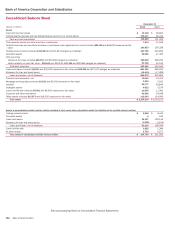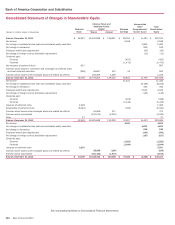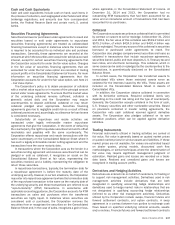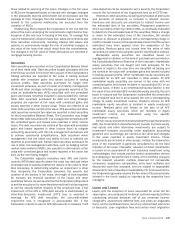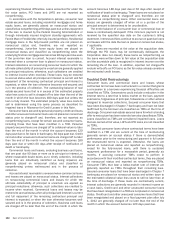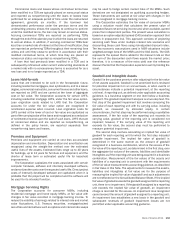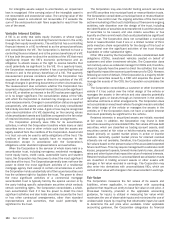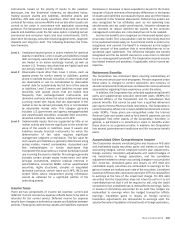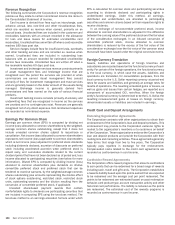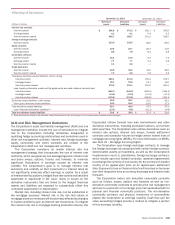Bank of America 2014 Annual Report Download - page 154
Download and view the complete annual report
Please find page 154 of the 2014 Bank of America annual report below. You can navigate through the pages in the report by either clicking on the pages listed below, or by using the keyword search tool below to find specific information within the annual report.152 Bank of America 2014
experiencing financial difficulties. Loans accounted for under the
fair value option, PCI loans and LHFS are not reported as
nonperforming.
In accordance with the Corporation’s policies, consumer real
estate-secured loans, including residential mortgages and home
equity loans, are generally placed on nonaccrual status and
classified as nonperforming at 90 days past due unless repayment
of the loan is insured by the Federal Housing Administration or
through individually insured long-term standby agreements with
Fannie Mae or Freddie Mac (the fully-insured portfolio). Residential
mortgage loans in the fully-insured portfolio are not placed on
nonaccrual status and, therefore, are not reported as
nonperforming. Junior-lien home equity loans are placed on
nonaccrual status and classified as nonperforming when the
underlying first-lien mortgage loan becomes 90 days past due even
if the junior-lien loan is current. Accrued interest receivable is
reversed when a consumer loan is placed on nonaccrual status.
Interest collections on nonaccruing consumer loans for which the
ultimate collectability of principal is uncertain are generally applied
as principal reductions; otherwise, such collections are credited
to interest income when received. These loans may be restored
to accrual status when all principal and interest is current and full
repayment of the remaining contractual principal and interest is
expected, or when the loan otherwise becomes well-secured and
is in the process of collection. The outstanding balance of real
estate-secured loans that is in excess of the estimated property
value less costs to sell is charged off no later than the end of the
month in which the loan becomes 180 days past due unless the
loan is fully insured. The estimated property value less costs to
sell is determined using the same process as described for
impaired loans in Allowance for Credit Losses in this Note.
Consumer loans secured by personal property, credit card loans
and other unsecured consumer loans are not placed on nonaccrual
status prior to charge-off and, therefore, are not reported as
nonperforming loans, except for certain secured consumer loans,
including those that have been modified in a TDR. Personal
property-secured loans are charged off to collateral value no later
than the end of the month in which the account becomes 120
days past due or, for loans in bankruptcy, 60 days past due. Credit
card and other unsecured consumer loans are charged off no later
than the end of the month in which the account becomes 180
days past due or within 60 days after receipt of notification of
death or bankruptcy.
Commercial loans and leases, excluding business card loans,
that are past due 90 days or more as to principal or interest, or
where reasonable doubt exists as to timely collection, including
loans that are individually identified as being impaired, are
generally placed on nonaccrual status and classified as
nonperforming unless well-secured and in the process of
collection.
Accrued interest receivable is reversed when commercial loans
and leases are placed on nonaccrual status. Interest collections
on nonaccruing commercial loans and leases for which the
ultimate collectability of principal is uncertain are applied as
principal reductions; otherwise, such collections are credited to
income when received. Commercial loans and leases may be
restored to accrual status when all principal and interest is current
and full repayment of the remaining contractual principal and
interest is expected, or when the loan otherwise becomes well-
secured and is in the process of collection. Business card loans
are charged off no later than the end of the month in which the
account becomes 180 days past due or 60 days after receipt of
notification of death or bankruptcy. These loans are not placed on
nonaccrual status prior to charge-off and, therefore, are not
reported as nonperforming loans. Other commercial loans and
leases are generally charged off when all or a portion of the
principal amount is determined to be uncollectible.
The entire balance of a consumer loan or commercial loan or
lease is contractually delinquent if the minimum payment is not
received by the specified due date on the customer’s billing
statement. Interest and fees continue to accrue on past due loans
and leases until the date the loan is placed on nonaccrual status,
if applicable.
PCI loans are recorded at fair value at the acquisition date.
Although the PCI loans may be contractually delinquent, the
Corporation does not classify these loans as nonperforming as
the loans were written down to fair value at the acquisition date
and the accretable yield is recognized in interest income over the
remaining life of the loan. In addition, reported net charge-offs
exclude write-offs on PCI loans as the fair value already considers
the estimated credit losses.
Troubled Debt Restructurings
Consumer loans and commercial loans and leases whose
contractual terms have been restructured in a manner that grants
a concession to a borrower experiencing financial difficulties are
classified as TDRs. Concessions could include a reduction in the
interest rate to a rate that is below market on the loan, payment
extensions, forgiveness of principal, forbearance or other actions
designed to maximize collections. Secured consumer loans that
have been discharged in Chapter 7 bankruptcy and have not been
reaffirmed by the borrower are classified as TDRs at the time of
discharge. Consumer real estate-secured loans for which a binding
offer to restructure has been extended are also classified as TDRs.
Loans classified as TDRs are considered impaired loans. Loans
that are carried at fair value, LHFS and PCI loans are not classified
as TDRs.
Secured consumer loans whose contractual terms have been
modified in a TDR and are current at the time of restructuring
generally remain on accrual status if there is demonstrated
performance prior to the restructuring and payment in full under
the restructured terms is expected. Otherwise, the loans are
placed on nonaccrual status and reported as nonperforming,
except for the fully-insured loans, until there is sustained
repayment performance for a reasonable period, generally six
months. If accruing consumer TDRs cease to perform in
accordance with their modified contractual terms, they are placed
on nonaccrual status and reported as nonperforming TDRs.
Consumer TDRs that bear a below-market rate of interest are
generally reported as TDRs throughout their remaining lives.
Secured consumer loans that have been discharged in Chapter 7
bankruptcy are placed on nonaccrual status and written down to
the estimated collateral value less costs to sell no later than at
the time of discharge. If these loans are contractually current,
interest collections are generally recorded in interest income on
a cash basis. Credit card and other unsecured consumer loans
that have been renegotiated in a TDR are not placed on nonaccrual
status. Credit card and other unsecured consumer loans that have
been renegotiated and placed on a fixed payment plan after July
1, 2012 are generally charged off no later than the end of the
month in which the account becomes 120 days past due.


